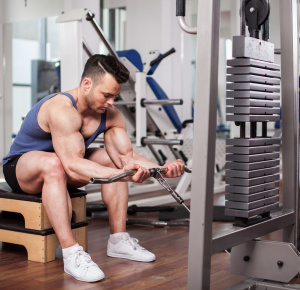 I know there are power lifters and weight lifters who are not concerned about getting a pump from their workouts. While many of them do want to gain some size to aid in the process of gaining strength, they often do so by emphasizing the use of heavy weights and lower rep ranges which are not known for producing much of a pump. However, there are some who feel that a substantial pump can play a role in enhancing strength gains. Of course bodybuilders are known for craving the sensation of getting a pump and depend upon it for maximizing muscle size.
I know there are power lifters and weight lifters who are not concerned about getting a pump from their workouts. While many of them do want to gain some size to aid in the process of gaining strength, they often do so by emphasizing the use of heavy weights and lower rep ranges which are not known for producing much of a pump. However, there are some who feel that a substantial pump can play a role in enhancing strength gains. Of course bodybuilders are known for craving the sensation of getting a pump and depend upon it for maximizing muscle size.
For those who believe in the benefits of getting a pump during a workout, I am going to address this issue within the context of Precision Point Training. One aspect of Precision Point Training is that developing fatigue is avoided. Reps are only continued within a set as long as they can be done forcefully. When there is a sudden decrease in rep speed or rep rhythm, the lifter terminates the set. In addition, if a lifter notices that they have reached a set where they are no longer at full strength in comparison with previous sets, the lifter stops doing sets for that exercise and body part. Bodybuilders and lifters may find it hard to get a pump under these conditions because a pump often is often achieved by pushing hard into a set and doing a lot of sets. With this in mind, I have some suggestions for those who would like to get a pump while using Precision Point Training.
First of all, most people are not going to get much of a pump from using heavy weights and low reps. In order to get a pump, a weight range that allows you to hit your marker rep between twelve to fifteen reps is helpful. This must be done on a regular basis if you want to train your body to get pumped. For me, this means using the twelve to fifteen rep range a minimum of three times per week, and I’ll get an even better pump from hitting twelve to fifteen reps five times per week. Having said this, I must warn you that doing more than one set of twelve to fifteen reps for an exercise has always backfired for me and caused a loss of strength if I kept it up for more than a week and a half. One set worked really well, two sets did not. More explanation is needed.
I’ll give you an example of how I would use the twelve to fifteen rep range when doing the bench press. Before I use twelve to fifteen reps, I would start benching for two or three sets using light weights that are less than 50% of my one rep max. I’ll stop each of these sets at 10 reps and won’t even come near my marker rep. Then I’ll increase to a weight that will allow me to do a set of five to eight reps before reaching my marker rep. I know from experience that that I will only be able to do one more set before my strength starts to decrease which will make it my last set. So for my final set of the bench press, I decrease the weight enough to allow me to perform fifteen reps before reaching my marker rep. I am then done with that exercise and body part. Other people may be able to do more sets than I can before losing strength, but the main point is that if you are going to use the twelve to fifteen rep range in every workout, only use twelve to fifteen reps on the last set of an exercise, and stay within the boundaries of your marker rep.
For those who want some additional strength and size in your arms, you can also consider getting a pump in your biceps and triceps by doing extra workouts for your arms only. It’ll be a short workout. If you’re like me and you don’t have time to go to a gym for extra workouts, you can get a pair of dumbbells and do the extra workouts at home. Just do one or two sets for both dumbbell curls and triceps extensions while using a weight that will allow you to hit your marker rep at around twelve to fifteen reps. You should be able to do the whole workout in six to seven minutes tops, and can do it three to five times per week. Take a week off from extra workouts every three weeks. The extra workouts are likely to cause your arms to respond by pumping quicker and easier than previously by doing this.
Maybe you’re like me and you don’t place a big priority on getting a pump, but sometimes a change is helpful and the methods that I just described may give your muscles a boost if you want to give them a try. Best of training to you.
